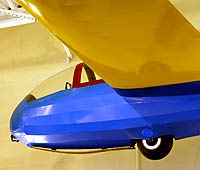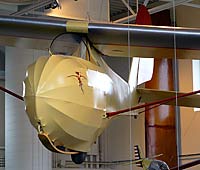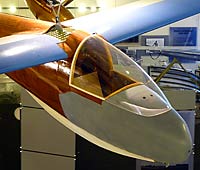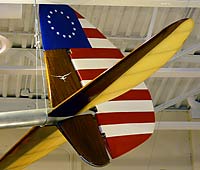National Soaring Museum Photos
The National Soaring Museum is located in Harris Hill near Elmira New York.
The National Soaring Museum is an aviation museum that focuses on gliders and sailplanes and related exhibits. The building is fairly new and comfortably heated and air conditioned. The sailplanes and gliders are very well displayed and the lighting is good. You can't touch but you can get right up close and personal with all the sailplanes that are on the floor levels as there are no rope or other barriers keeping visitors at a distance. Not many museums allow that kind of access to their exhibits and it's a real treat. Most of the gliders are civilian, but they do have a WWII Waco CG-4A Hadrian Troop/Cargo glider and a Laister Kauffman TG-4A two place sailplane that was used to train glider pilots in preparation for the WWII D-Day Landings. Interestingly the Laister Kauffmans were withdrawn from service late in the war as it was found their flight characteristics were very different from the Waco Hadrian and did not transfer directly to flying a large loaded troop transport glider. The Waco CG-4A is open to visitors and you can walk inside and get a feel for the size and construction of this historic military glider. You'll also get a good look at the cockpit layout, instrumentation, and controls.
The museum exhibits consist of gliders and sailplanes from the 1920s right up till the present day, with a couple of early Wright Brothers replicas to round off the timeline. Several aircraft have gorgeous mahogany plywood fuselages and are works of art in themselves. I thought the Bowlus Senior Albatross was the most striking glider in the collection. The Albatross has a real birdlike appearance to it with its unusual side facing cockpit openings and beaklike nose. It set an unofficial world record distance of 153 miles in 1934 and won the 1934 and 35 National Soaring Contests. The Olympia Meise was designed in Germany to compete in the 1940 Olympics, which were cancelled due to the start of WWII. The canopy uses a complex framework and curved plexiglas sections to achieve a smooth surface yet still have excellent visibility.
Many of the gliders are home built - made from kits an owner could build in their garage, with construction ranging from early wood and fabric, bonded aluminum, fiberglas reinforced plastic to carbon fiber composites. The Schweizer corporation has a large presence (their factory is just a few miles away) with a number of their beautiful sailplanes on display in their own gallery. Also in the Schweizer Gallery is a dive brake demonstrator consisting of a sailplane wing where you can pull a handle to deploy and retract the dive brake and clearly see how it is extended. All of the exhibits have been restored to a very high standard with the exception of the Zogling Primary Glider which is still in original condition in order to preserve and display the original fabric covering. Several of the sailplanes are historic record holders or soaring competition winners.
One exhibit I found interesting was the 1937 DuPont Winch truck. It's essentially a 1937 General Motors pickup truck, with a high speed winch mounted on the pickup bed. It appears to be powered by a central power takeoff from the truck's transmission with multiple rubber drive belts driving the winch drum. The truck would winch the sailplane in at high speed down the runway, getting it airborne. When the glider reached an altitude high enough to safely clear the hill the pilot would disconnect the tow rope from the glider and continue riding the air currents off the ridge. The line in the winch feeds through rollers and a guillotine. If the winch operator noticed that the line was not being released from the sailplane, he would trigger the guillotine and the blade would snap down, severing the tow line. This was only done in an emergency. If the line were not disconnected, the tethered glider would continue forward to follow a tight arc over and down into the ground.
The National Soaring Museum is located right outside the NY town of Elmira on the high hilltop of Harris Hill, NY, in the southern central portion of the state. . The staff were very helpful and friendly, and the tour is self guided. There is no food on site, but there are a variety of fast food establishments right off of RT 17 (Being renamed to Rt-86) near the museum. A ramp eases access for wheelchairs to the main entrance, and there is an elevator between floors so the museum is very handicap accessible. Check the National Soaring Museum's Website for hours and directions.
If you have an interest in sailplanes, or even aviation in general, pay these folks a visit when you are in the area. The staff were great, the sailplanes are beautifully restored and well exhibited and lit and the museum is bright, new, and clean.
If you have the time there is one more aviation museum in the Elmira area, the Wings of Eagles Discovery Center Museum in Horseheads. It is only about 5 miles from Wings of Eagles and both museums could be easily visited in a day. |



